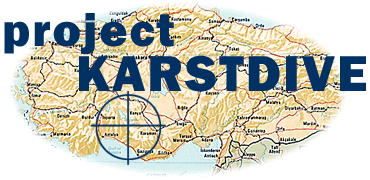Project Karstdive: 3D mapping - Overview
Project Karstdive: 3D mapping - Overview
Three Dimensional Geometric Modeling and Visualization of Phreatic Karst Caves with Implications for Hydrologic and Geomorphic Studies
Todd R. Kincaid, Hazlett-Kincaid, Inc.
Extensive surveys of several underwater cave systems have been conducted in the Floridan aquifer of north Florida and the Taurus Mountain and Antalya Travertine aquifers of southern Turkey. Azimuth, depth, width, and height measurements were collected at several survey stations along linear paths through the conduits. These measurements were used to produce Cartesian coordinates for points along the cross-sectional perimeter of the cave at each survey station. Additional cross-sections were generated between survey stations by linear interpolation. Using the Cartesian coordinates and Earth Vision modeling software, accurate three dimensional geometric models were generated for all the phreatic cave systems investigated.
Hydrologic and topographic maps were superimposed onto the conduit models to investigate the relationship of those variables to conduit development. The most significant local recharge areas were easily identified where the conduits trend closest to land surface and are not overlain by a confining layer. Two morphologic categories that describe conduit development have been identified. Single conduit or dendritic conduit systems form where the aquifer is confined and are associated with larger hydraulic gradients. Anastamose conduit systems form where the aquifer is unconfined and are associated with smaller hydraulic gradients. In addition to the hydrologic and topographic maps used in this study, any data such as water chemistry currently being collected by several multidisciplinary researchers can easily be incorporated into these models.
The lack or inaccessibility of conduit maps has been a major inhibitor to phreatic karst research. This modeling technique offers exciting new possibilities for investigating and visualizing phreatic karst cave systems because it uses available survey data to generate accurate three dimensional conduit models over which any other relevant data can be viewed.
Typical 2-D cave maps offer limited ability to visualize and thus interpret the data they may actually contain. My goal with this work is to produce 3-D, fully manipulative models from survey data that can be collected or approximated by the cave explorer.
The first step in producing a 3-D model from typically available survey data is to fill in the gaps between survey stations. I accomplish this by linearly interpreting between x,y,z coordinates calculated for the walls at each survey station. A polygon is then drawn around each survey station connecting the walls to ceiling and floor coordinates also determined from the survey data. Finally, one or more large data sets made up of all the x,y,z coordinates are constructed that contain all the points associated with the cave system being modeled. I have written three programs with Matlab to convert cave survey data into x,y,z coordinates, interpret points between survey stations, and create the data files needed by the subsequent modeling software.
Next, the x,y,z coordinates are entered into the modeling software. Though there are several software packages available capable of producing these models, I'm using EarthVision written by Dynamic Graphics Inc., which is a UNIX based modeling and visualization program designed for the petroleum industry to model subsurface geology for reservoir predictions. At the University of Wyoming, we are running EarthVision on Silicone Graphics Indigo 2 workstation computers.
I've used two methods to produce useful models of the cave systems I'm studying. One is a volumetric approach and is only capable of modeling the geometry of the cave system. The other method, which I call the grid clipping method, is significantly more involved but allows an additional parameter to be modeled throughout the cave system such as velocity or water chemistry.
In the volumetric approach, all of the cave points are assigned a common modeling parameter i.e. some number unique to the points in the cave. Next, an additional perimeter is calculated at each survey station falling 2m outside of the actual cave wall perimeter. All of those points are then assigned a different modeling parameter so that the girding program can distinguish between points falling in and out of the cave. My current work is focused on using this volumetric technique to develop the idea that karst cave systems have a fractal nature. By calculating a model at different grid spacings which correlate to measurement scales, I am investigating how space filling a particular system is i.e. calculating the fractal dimension.
The initial output will simply be a large block representing the size of the block of host rock containing the cave. However, sequential layers defined in the program can then be peeled away to reveal the 3-D structure of the cave system inside. Once all of the layers are peeled away, the computer can easily calculate the volume and surface area of the cave system. Tighter grid spacings in the model calculation produce more accurate representations of the cave but require substantially more computer power.
The grid clipping method demands that separate 2-D grids be calculated that model the upper and lower surfaces of the cave system. A polygon must also be calculated that traces the walls of the cave. The accuracy of the model is very dependent on the accuracy of each of the component grids. Once these grids are calculated, a 3-D grid of any parameter measured in the cave system can be clipped to reveal the geometry of the cave and the trend of the modeled parameter throughout the system.
Once a model of the cave system is calculated with either method it can be easily compared to other types of data such as topography, water levels in the aquifer, or the extent of confining layers.
Some of the models contained in this web site are displayed in relation to the local topography.


